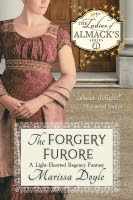Three young, widowed duchesses, each with a reason not to
marry again. One duke, honor bound to give them a happy-ever-after so he can
find his own. Let the matchmaking begin!
Since Claudia, Dowager Duchess of Tyneham, became a widow, she’s had to manage two feckless dukes, all their holdings, and the ill-chosen staff they left behind, all to protect the loyal staff and two other dowagers who call Tyneham Manor home. So when the new Duke of Tyneham in his august wisdom sends an architect out of the blue to remodel the manor, she’s ready for another fight. But she certainly isn’t ready for a winsome smile and a charming address to cut through all her defenses.
Remodeling an architectural treasure like Tyneham Manor could make widowed Ben Warden’s career and help him support his young son, if he can convince Claudia to trust him with the house she considers her home. Yet even as he and Claudia draw closer, it becomes apparent that everyone from the new duke to Her Grace’s lady’s maid is conspiring to give her a well-deserved happily-ever after, with Ben! What could a rising architect possibly offer a woman who has position, prestige, and wealth?
As secrets come to light and scandals unfold, can Ben convince his extraordinary duchess to take the most extraordinary chance of all—falling in love?
Available
Directly from me https://payhip.com/b/17Fkf
Smashwords https://www.smashwords.com/books/view/1737166
Amazon https://www.amazon.com/His-Extraordinary-Duchess-Regency-Romance-ebook/dp/B0F2QLJLCZ
Barnes and Noble https://www.barnesandnoble.com/w/his-extraordinary-duchess-regina-scott/1147201431?ean=2940184729824
Apple Books https://books.apple.com/us/book/his-extraordinary-duchess/id6743880725
Kobo https://www.kobo.com/us/en/ebook/his-extraordinary-duchess
Bookshop.org https://bookshop.org/p/books/his-extraordinary-duchess/ba0dd5f1c2f07092?ean=9798231825608
Universal Link https://books2read.com/u/mdx6ER














